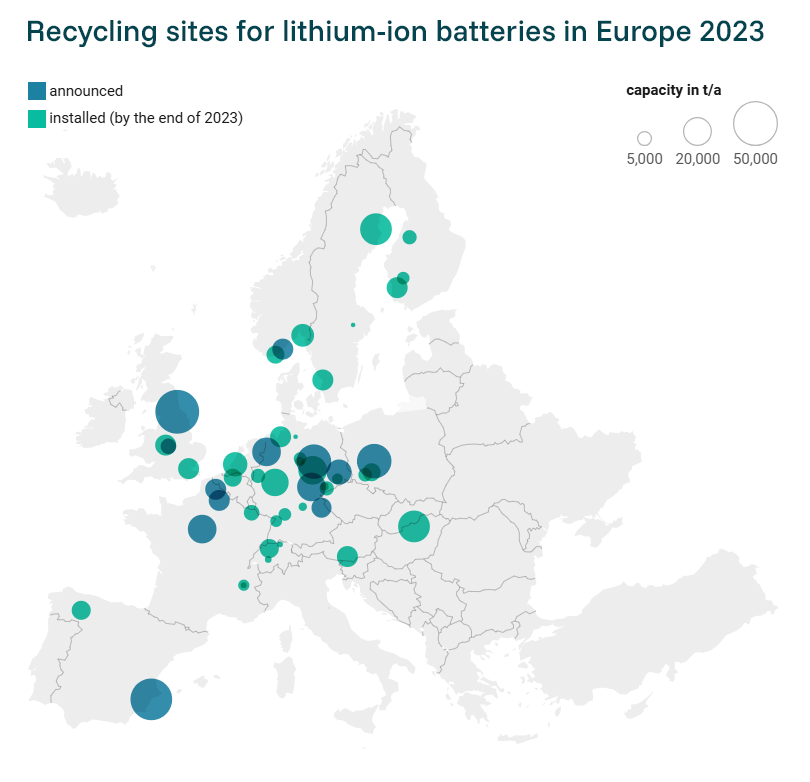Expected impacts
Although the current supply of recyclable materials in Europe is dominated by scrap from production lines, analysts are expecting a wave of end-of-life (EoL) batteries to hit the market by 2030, as the first generation of electric vehicles (EVs) reaches the end of their lifespan.
The RESTORE project, backed by the European Union, is set to accelerate the growth of competitive and sustainable battery recycling and manufacturing industry. Not only are these recycling processes designed to recover high-purity materials from end-of-life (EoL) electric vehicle (EV) and domestic lithium-ion batteries (LIBs), but also to minimise environmental impact. Successful demonstration and validation of these processes will support the European battery industry meet the goals of the Battery Directive and the Critical Raw Materials Act, delivering towards a more sustainable and competitive industrial ecosystem.
OUTCOMES:
Economic significance:
To ensure low-cost process by
i) reducing the number processing steps and time
ii) using flexible technologies with minimum CAPEX and OPEX and easy for scaling up
iii) increasing recovery efficiency and introducing direct recycling approach
iv) fast and efficient processes
Environmental significance:
Zero waste approach and circular to evaluate the need for reuse/refurbishment/recycling of all strategic material with technologies posing less environmental impacts.
Social sustainability:
Conducting risk assessment for worker safety throughout the entire process, while evaluating safety and sustainability protocols in the design phase.
Expected mid-term outcomes: Industrial leadership and increased autonomy in key strategic value chains
Economic & Tech
- CRM production in Europe where >95 % of the CRM will be recovered to decrease the supply risk;
- ii) domestic CRM processing and production in Europe, with long term material supply deals between European companies, enabling reduced price volatility and more stable investment environment;
- iii) shorter material recycling routes enabling the processing and production of battery-grade materials at lower cost for the benefit of European battery-based industry
The direction of the EU battery industry towards the zero-waste concept by developing holistic, materials…
The diversity of the consortium, linking collection and recycling companies, battery materials and system producers and key innovators across Europe, aims to implement a zero-waste approach that ensures the complexity of waste streams available in battery applications is recovered and valorised efficiently:
- EV pack components: RESTORE will avoid the mixing of materials from the start, by providing autonomous robotic technology that can recognise the different components and dismantle them for their valorisation in a more efficient way.
- Mixed waste: RESTORE will use sensor-based sorting equipment that can sort the different flakes according to their material composition.
- Process water treatment: RESTORE will treat the process water with technologies such as the recovery of valuable Li using a low energy electrochemical flow cell. RESTORE will ensure the water will be purified in economic way for its reuse in the battery recycling process.
Circularity
Safe and sustainable processes:
- Circularity of electrode materials: RESTORE will enable the separation of cathodic and anodic materials at high purity using safe and sustainable technologies [e.g. delamination, unwinding using green solvents, safe beneficiation processes with biodegradable reagents etc.]
- Circularity of non-metallic elements: Electrolyte solvents containing Li and binder will be recovered in RESTORE using safe and sustainable scCO2 [supercritical CO2] process with safe bio-based cosolvent.
Fire reduction: RESTORE will reduce this safety risk by developing fast and safe discharging technique for domestic batteries using novel ion exchange resin.
Environmental
Safety
Scale and significance: RESTORE is expected to bring major improvement by the end of the project on the purity and recovery yield of all battery materials as follows:
- Improving the purity and yield of BM at industrial lines
- High purity separated cathodic and anodic materials
Electrolyte, binder and separators.
Expected long-term outcomes

The RESTORE project is set to make a significant impact on Europe’s economy and its journey towards climate neutrality.
By aiming to meet the EU Batteries Directive’s ambitious targets—recycling at least 70 % by weight of LIBS batteries by 2030 and recovering over 95 % of critical raw materials like Co, Ni and Cu, and > 80 % of Li by 2031—RESTORE will help reduce Europe’s dependence on imported raw materials. It will additionally stabilise material prices and keep Europe’s battery industry competitive on the global stage.
Who could benefit from the RESTORE tech solutions and findings?
Battery collectors
Access to a flexible and adaptable process to identify and sort
waste batteries by chemistry
to determine their value.
Battery recyclers
Purer feed to improve their existing processes with new disruptive technologies, like direct recycling, boosting competitiveness and benefiting from the circular economy.
Cathode & anode material producers
Access to active materials synthesised directly from recycling processes at low cost.
Battery cell manufacturers
Use of electrodes from recycled materials, meeting the recycling targets established in the EU Battery Directive and the CRMA.
EU & End-product manufacturers
Meeting the sustainability KPIs and reducing demand from raw materials from third countries.










